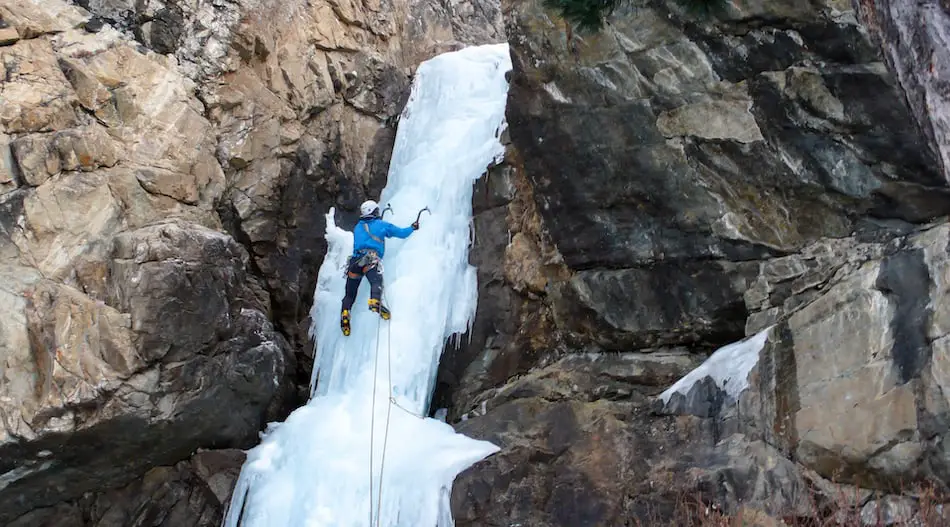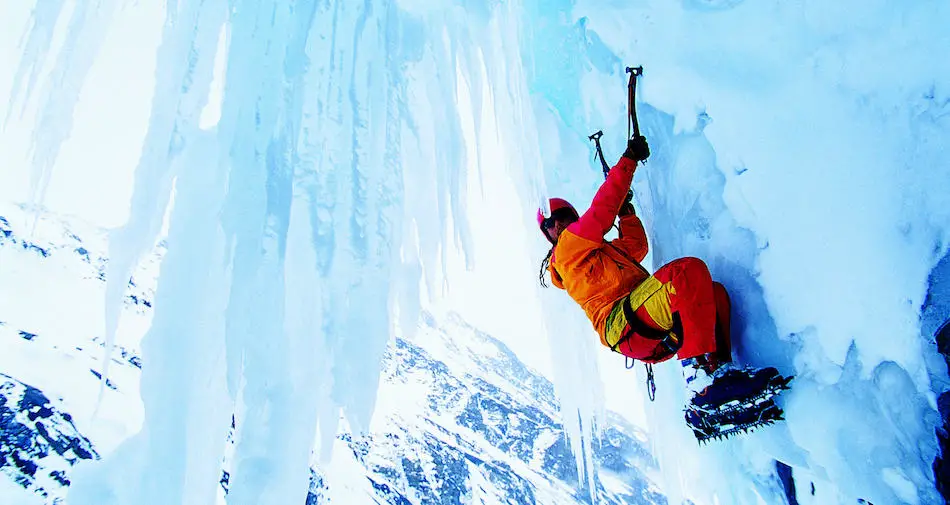
The second time I ever went ice climbing, I was eager to jump on a lead because I didn’t know the risks. I’ve created the following guide to highlight some of those risks to you.
So, if it dangerous to lead while ice climbing? Yes, leading while ice climbing is highly dangerous due to the increased consequences of a fall. These consequences can include broken bones, damaged equipment, and head trauma.
The danger of leading while ice climbing stems from the fact that ice climbing falls on lead are far riskier than, say, rock climbing falls. This is due to a lack of what I call ‘clean’ falls— that are, falls in which your entire body comes off the surface in near-synchronization and you’re able to control the fall. Ice climbing’s utilization of tools and sharp spikes (specifically, the crampons on your feet) make it more difficult to take a clean fall. This can lead to a myriad of injuries.
The Danger of Falling While Ice Climbing
To understand how dangerous leading on ice climbing is, you need to understand the impact that a fall could have.
Now, I’m going to go out on a limb and say that most people who want to get into ice climbing are probably rock climbers; if you rock climb, there’s a good chance that you lead climb and, have therefor, taken a fall before.
Falls in rock climbing are, most of the time, not a big deal. This is because, once one or both of your hands lose traction on the rock, your feet tend to come off fairly easily, and you’re able to release yourself from the wall in a controlled manner. This allows you to a) separate yourself from the wall, and b) maintain your bearings as you fall and be in good position to recover once the rope catches you.
In ice climbing, it’s much harder to take ‘clean’ falls such as these. This is due mainly to the crampons that you wear on your feet. Ice climbing crampons feature sharp blades on the toe with a serrated bottom edge. These are designed to be driven into the ice until they stick in place.

This ability of a crampon to gain purchase is what makes ice climbing possible in the first place. However, it also has the effect of making falls detrimental. Remember, the serrated edge on your crampon is on the bottom. The more weight you put on it, and the more downwards force you exert, the more firmly it’s going to stick into the ice.
To understand why this is so bad, let’s compare what happens when ice climbing vs rock climbing if both of your hands suddenly lose their traction on the wall:
When rock climbing, your upper body would start to fall downwards and backwards once your hands go. Almost immediately, your feet would lose their purchase and slide off the rock. Your legs, which are no longer attached to the wall, will begin to fall as well, staying below your upper body.
Ninety-nine percent of the time, you’re going to recover perfectly well from this fall. Now, let’s contrast this with what happens when you go ice climbing:
Your hands let go, and you begin to fall. As with before, your upper body tips backwards away from the wall, and gravity begins to pull you down. Now, however, your feet don’t cut loose. They’re not sticking to the wall via rubber-on-rock friction; they’re driven into place by your crampons. As you fall, you drive the crampons deeper into the ice, where they bite and stick.
Now, as you fall backwards, your feet stay in place even as your upper body keeps going down. This places an insane strain on your ankles, knees, tibia, and femur; it’s not uncommon for one or several of these to become damaged.
Eventually, the force on your crampons will be too much and they’ll pull out. At this point you’ll be way out of position for your fall, with the risk of tangling up in your rope on the way down or swinging back into the wall. Furthermore, there’s the chance that your crampons will catch again on the way down, which could lead to even more injuries.
Falling while ice climbing is no joke, even for the experts. Will Gadd, one of the best climbers in the world, says:
‘Ice climbing falls will likely result in a minimum of badly broken leg, ankle, head, pelvis, neck, back, or all of this list.’
The goal when ice climbing is to never fall throughout your entire career, because of how dangerous it is and how detrimental the effects could be. This risk of falling means that leading while ice climbing is indeed dangerous, and it’s not something that you should engage in until you’re sure you have the requisite skills and experience.
How Good Do You Have to Be to Lead While Ice Climbing?

So, now that we know how difficult it is to lead while ice climbing, let’s discuss how much experience you need to have before you can safely do it.
There’s no hard-and-fast rule, but there are some guidelines. Will Gadd, who knows a thing or two about ice climbing, suggests that you should do at least 150 laps on top rope before you decide to lead. That would equate to about 30-50 days out in the mountains. Another one of my friends, who did an entire semester learning about mountaineering, spent an entire season doing top-rope climbs (in which he went ice climbing every single week) before leading.
Another important thing to note is the difficulty of the ice climbs. It’s essential to take a step down once you start leading. If you can do WI-4 or WI-5 on top rope, you should probably start your leads on some WI-2’s. The general rule for ice climbing is that if you wouldn’t feel comfortable free soloing something— that is, you’re not absolutely confident in our ability to climb it without a fall— you shouldn’t lead it. Such is the danger of an ice climbing lead.
Other Hazards
Finally, aside from the increased danger of taking a fall, there are a couple of other hazards that you need to be aware of when leading on ice:
Icefall
This usually tends to be more dangerous for your belayer than for the climbing, but icefall is still something you should be aware of when you’re leading. Whether it’s loosened from above you or pulled free by your own axe, tumbling ice is never a good thing to have to contend with.
It’s not just yourself that you need to look out for, either. If your belayer gets clobbered by a piece of ice, you’re going to find yourself fairly far up shit’s creek. Always make sure you check that they’re in a safe position when you climb, and do your best to call down any falling ice so they’re aware of it.
Avalanche Risk

This applies more to those who are climbing alpine ice, but avalanche risk is an often-ignored component of ice climbing that can still apply to cragging or single-pitch climbs. Often, the place where waterfalls form also tend to be good avalanche chutes, heightening the risk that something’s going to come loose above you and start tumbling down.
One of the main difficulties with this hazard is that it’s very hard to predict, given the fact that you won’t even see the snow above your ice climb; that makes it impossible to judge its quality. You need, therefor, to make your judgements off of other factors. Trip reports will often include a note on the avalanche danger of an ice climbing. Most mountain ranges have avalanche reports that will tell you about the quality of the snow. You can read the weather forecast and try to predict if it’s going to be a fairly avalanche-prone day.
Whatever you do, always make sure to take the necessary precautions to ensure your safety. Leading while ice climbing is no joke, and you need to look after yourself.
